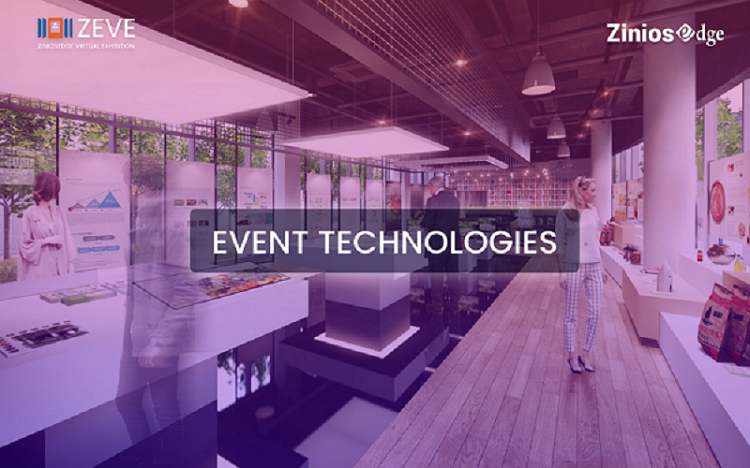
Top Event Technologies and Trends for 2020
Events are getting more mesmerizing with the aid of technological innovations. Specifically, the new add-on to this sector-‘ virtual event platforms’ are adding more value in this time of the pandemic.
However, event hosting is not a standalone process, whether it is a physical or virtual event! Helpfully, there is a range of innovative technologies that helps to turn the events more eventful such as mobile technology, event management software, 3D mapping, Augmented Reality, Virtual Reality, Mixed Reality, Emotional/facial Recognition using AI, Wearables, and so on.
Scope of Event Technologies
Interestingly, over the last two decades, the event industry has expanded a lot in terms of technological advancements. There were a lot of experiential options got introduced in the field, and more affordable yet effective virtual event platforms have also emerged.
Event technologies today is witnessing such a massive receptiveness as the event organizers and businesses are investing more in it. We cannot ignore that the current pandemic paved the road to such a disruptive change in the way events are hosted.
According to a study report, to make the events engaging, event managers are reportedly spending more than 52% of their event budget on various technologies and their enablers. Besides, as the world is contained like never before, virtual events find their grip to overthrow the need of physical events. These virtual event platforms are offsetting the complex processes involved in conducting an event.
Ultimately, the process of making events exciting begins with the invitation mail to the live event podium/virtual podium. Substantially, the event hosting technologies ranging from webinar tools, ticketing systems, event management software to innovations like Virtual Reality and artificial intelligence collectively shares the credit of the success of a delightful event experience.
But, the dilemma lies in figuring out the best among them remains relevant, and still, it confuses a lot. So, in this blog, we are giving you the insight to understand the different technologies that enabled events more experiential.
Here is a list of some of the event technologies that are improving attendee experience:
1. Virtual Event Platforms
Virtual events are the new normal in the corporate event hosting practice. As the pandemic contained the people in their shelters, virtual event platforms serve as an essential solution to run the businesses right from the safe zones.
These platforms have overturned the conventional way of meetups and running business summits. It gathered all the elements involving in an on-site meeting itineraries into a single online platform such as
- Audience Invitation Channels
- Welcome Lobby
- Auditorium and Exhibition Hall
- Brand Promotion Booths
- Resource Centers
- Networking Corners
- Breakout and Keynote Sessions
- Live and Pre-recorded Sessions
- Event Polls and Surveys
This paves the way for a convenient event hosting model for organizations and institutions. Many business organizations and institutions adopted this mode for running global events successfully. To illustrate, Facebook and Google have launched their yearly summits online via virtual events platforms. Participants have streamed the events online and interact more realistically over these virtual platforms.
It offers more control and engagement opportunity for both the organizers and facilitates dynamic event activities quite engagingly. However, leaving all the skepticisms, online events are gaining more attraction for its potential to earn more leads, close deals, and one-on-one interaction possibilities with the audience.
2. MOBILE PHONES TECHNOLOGY
Smartphones have penetrated more than half of the US and UK markets. Hopefully, we can believe that people attending your event will be one of them using smartphones.
Here go some ways that mushrooming mobile techs adds to the event experience
- ‘Responsive’ event website: Event websites are one of the essential factors that ignite the spark of an event experience. However, as people are more inclined to their mobile devices, developing a mobile-friendly website design (responsive way) will help to improve the overall experience from the beginning. And this makes it easier for users.
- Incredible event app: This will help your attendees to travel the event location, study more about the regional speakers, find out the sessions to attend, and meet other attendees.
There are provisions in some apps where the attendees can simply scan the name-badge to know about them.
- Notifications as push messages: Attendees will be notified with push messages while the event takes place. This will bridge the communication gap between them.
3. SOCIAL MEDIA INTEGRATION
You can make use of social media by tracking people’s mobile usage. You can promote the event by creating hashtags, sharing the event posts on social media platforms like Facebook, LinkedIn, Twitter, etc., and tag photos and videos of the individual events.
Ultimately, at this time, live-streaming is the most opted mode of attending an event. Social media and Mobile phones really make the best pairs that can create wonders in your event marketing efforts and attract more participants for virtual events.
“Social media + Mobile phones= Best pairs.”
To publicize your event efforts among attendees, you can make use of the techniques listed below:
- Create gridding Photo Challenge
- Mirror Selfie Stations
- Social Flag
- Social Wall
- Make Global Unified Hashtags
- #BestDishes
- Launch in-app polls
- Hold an Ask Me Anything on Instagram
- Make Click To Tweet Hashtags
4. FRAME VISUAL EXPERIENCE
The public is damn interested in augmented and Virtual Reality (AR &VR). Apps like Pokemon Go proves it.
Virtual Reality has enormous opportunities in meetings and events. Besides, it has the ability to mend the event industry completely, and it is doing it. VR also acts as a fun factor for the attendees that can offer experiential events in style.
To illustrate, the way Canada’s Wonderland brought the thrill of a roller coaster ride to homes via Virtual Reality was so experiential plus wining. It is proving that VRs importance in making events more vivifying than any other event technology in real-time.
Even though the working technique of VR is swaying your brain and paves a way to believe what is unreal, it gives an experience as if it is happening. When compared to the traditional videos, VR is more:
- Engaging
- Memorable
- Persuasive
- Interactive
Here are some ways to implement Virtual Reality in events:
- Conduct interactive Virtual Exhibitions
- Business Trade Fairs and Expos
- Create VR Games
- Use VR alternatives in every possible event
5. ORGANIZE POLLS AND SURVEYS FOR ATTENDEES
Giving a real-time experience and immediate feedback is the best way to engage the attendees and bring them into a lively spirit of events. Thus polls and surveys are the best way to get them into the spree.
These are the way; polls drive the attendees crazy in an event
- Interrogation: Asking questions during the presentation and getting instant results will turn the event more enjoyable.
- Polls or a survey booth: This helps to maintain a rapport among the attendees. Conducting surveys with a touchscreen or a tablet that reveal the results in real-time engages and attracts more people to give productive insights. Later you can send emails or messages as part of following it up and retain them for the upcoming events as well.
Live polls collect the real-time sentiments of the audience, and it can be used to improve the next event. For example, event organizers can collect popular queries collectively to address them. Organizers can collect comments and suggestions to answer in real-time. Also, event managers can add a bit of gamification with a cute gift in their live polls and survey as well.
Plus, event polls are rolling out in many ways such as graphic display, open text display, with moderation control measures, clickable image, word cloud, etc. Appropriate to the event and the audience gathered, polls and surveys are making events more experiential in Reality and in virtual space.
6. USE OF CREATIVITY TO SET THE MOOD
Unlike the other techy ideas, this may seem not very interesting to many. But interactive creative elements play a significant role in event technology success. Be it a virtual event or an on-site event audience love to spend time for something they interact with.
In fact, interactive creative elements can:
- Engage and welcome attendees
- Create an ambiance
- Set the mood
- Make the event professionally engaging
- Provides a class touch without much monetary loss
Interactive elements set the moods following the type, content, and the overall environment of the event. It plays an integral role in keeping the thrill alive and add more color to every event.
TOP TRENDS OF EVENT TECHNOLOGY:
Technological advancement is directly proportional to affordability, and it is also based on accessibility. Thus, being much affordable and accessible for all kinds of users, event managers incorporate more of such technologies into their events.
In effect of this, many creative and incredible new event technology has begun to take shape in this industry.
Some of them are as follows
1. Combined Reality
By combining the objects of the real world with that of the virtual world, event technologies grew up by creating natural environments for digital ones. This included Virtual and Augmented Realities and came to be known as Mixed Reality Continuum.
This is the most captivating experience that any event organizer can offer to the event-goers. Charity Water (a non-profit organization in New York) experimented with this technique to understand what they are doing in Reality. They gave VR gadgets to their attendees and brought them to the small villages in Africa to show them how they work among the downtrodden areas across Africa and let them experience the real-life response of people virtually. And this exponentially increased the donation, and more people voluntarily helped them for their endeavors further.
Likewise, companies and brands are using this incredible technology to give a life-like event experience to their users. Another example is -Budweiser (beer makers) used VR technology to provide visitors with an unforgettable experience by virtually talking them to their brewery and shown the end-to-end story of the beers that they are going to sip.
That was also a truly successful experiment that quadrupled their fan base, and they could gain loads of appreciation on the go.
Similarly, for launching new products, showcasing showrooms and features, and making events a step more engaging event and brand organizers are increasingly employing mixed reality technologies by far.
2. Personalization of Events
A personalized experience will let the attendees choose your event. This is, in Reality, a psychological move. When they feel like their likes and interests are also considered, it will make them more engrossed with your event.
For that, AI and IoT are the perfect duos that can help organizers to strategize and implement a personalized event plan for the people. It can help you to gather granular information to supply personalized content that grabs their attention to the experiences that they are searching for and gives a sort of gratification that their interests are considered by the organizers as well.
As AI helps the event managers to collect the personal touchpoint of people via their event applications or interactive websites, they could pivot and engage with the audience with the insights gathered. And further, this engaging, personalized communication helps to immerse the virtual event-goers far before they attend the events.
3. Automation of Event planning
You may not be aware of the fact that one of the most stressful occupations in the world is that of a corporate event planner. That’s why event automation trends are getting traction and acceptance. However, as a great relief, virtual events turned it into a controllable task within a centralized dashboard.
Let’s delve into the facts. Event automation tools and event hosting platform have made the coordinator’s job easier by freeing them up from the hectic repetitive tasks. As an event involves a multitude of the task, and as it is an assortment of different responsibilities, automation is an incredible solution to enhance the event experience.
Besides, they also help the project managers to have complete control over the event. Organizers can choose a lot of event automation software now. Else they can create customized virtual event applications that bring together all the teams such as marketing, sales, accounting, etc. This allows event managers to work and coordinate from a single platform rather than hopping on multiple platforms and software.
Bottom Line
Event Technology is a rapidly changing sector with futuristic innovations. The way virtual events have shifted the mode of hosting events is an obvious example. With event technology, which includes virtual event platforms, you can save money and make events more exciting and engaging, which will give you more business and ROI. In short, the approach to utilize these technologies determine the result you receive





Comments
No comments yet.